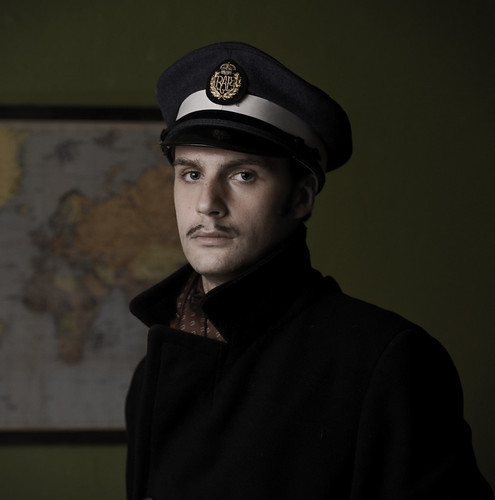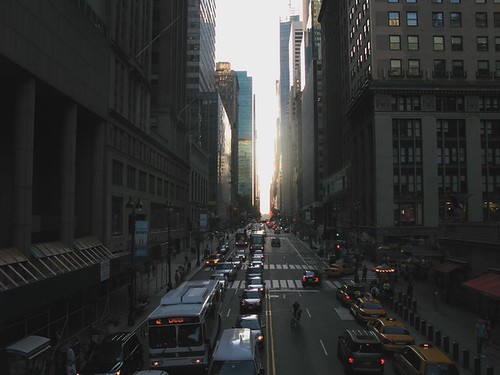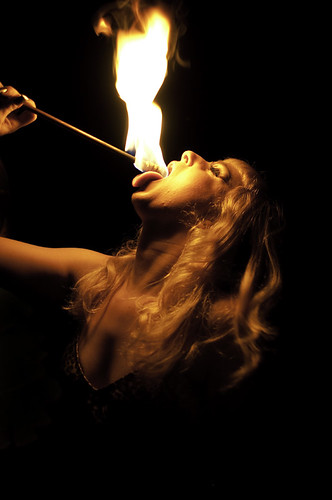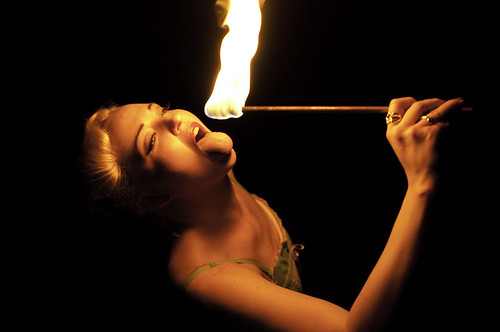In 2001, I decided to purchase a Nikon Coolpix 5000. I wanna say it cost me about $500 or so. It was a 5MP "high end" model, with a pretty decent lens, an articulated LCD screen (an important feature to me), and a flash hotshoe (which I remember thinking was also important). Creatively speaking, this camera did two things significant for me: a) it had really fantastic macro performance - it could focus on stuff that was less than an inch away from the camera (with some pretty serious falloff, granted), and b) the LCD screen - having the ability to compose shots without needing to have the camera held up to my face really changed the way I thought about composing pictures. Needless to say, a lot of the work I did with that camera was abstract and macro. But it was a good start.
From there, I moved onto the Nikon Coolpix 5400, which was basically an updated version of the 5000. Virtually identical, with a couple of minor upgrades. I got it because I had basically beaten the crap out of the poor little 5000, having carried it around all the time.
Still very much in the "hobbyist" frame of mind, my next camera was my first DSLR - the Nikon D70. This was another game changer for me. Suddenly, I was able to start using all of the old lenses that my dad and I had when I had first started out. As a bonus, because of the fact that I had been using Nikon digital cameras in the past, I was already used to Nikon's user interface design. I felt right at home with this camera very quickly.
Still working in the IT business, I was still well within hobbyist territory. I was getting more and more curious, however, and any time I'd run into a pro photographer (either as a client, or in passing), I'd spend as much time as I could talking shop and learning stuff. I'd been pretty familiar with all of the aspects of print production (scanning, printing, layout, retouching, etc), but I never really got into the actual picture-taking end of things.
Around this time, I was very active as a musician, and had many friends who were in many different bands. It became pretty commonplace for me to bring my camera to shows, and to help out with doing promo work here and there. One of my favorite tricks for getting cool shots at concerts was to stick one of my old Coolpix cameras on a monopod, and use the flip-out screen such that I could hoist the camera a good 10 feet in the air or so, and either with a remote or the self-timer, snap some "bird's eye view" shots of the action on stage. I was still shooting JPGs, and hadn't really gotten into using a flash.
Fast forward to 2006, when I moved from Chicago to New York City. It was a big turning point for me, and a lot of things were in the midst of shifting. I was taking a big break from music, and I was turning my back on a pretty well-established freelance career, in favor of starting over from scratch in a new city. I still had my D70, but I wasn't really that inspired, photographically. I had taken a position as a Mac Genius, working on the very first official overnight team at the only 24-hour Apple Store - Fifth Ave. This was an overall good experience for me, in that I was able to make some really great new friends quickly, and I was getting exposed to all sorts of interesting folks that would come into the store late at night for help.
One of these folks was an amateur photographer, and in our conversation about photo stuff, she happened to mention the word "strobist". I didn't really think anything of it at the time, but for some reason, it stuck with me. A few weeks after that, a friend of mine was having some sort of an event (I think it was a party or a concert; I can't really remember), but whatever it was, it had inspired me to think about photography again. And because this was an indoor-at-night thing, I knew I was going to need to use a flash (by this time, I had gotten myself an SB-600, which didn't really see much use). I remembered that "strobist" thing that girl at the bar had mentioned, and found David Hobby's website easily enough.
For the next few weeks, all I could think about was photography. I went back to my dad's place and raided his collection of gear for every single piece of flash-related equipment I could get my hands on. This was an old SB-16, an SB-24, and a couple of cheap slave sync gizmos. It was enough to get me started, though.
After chewing through the stuff I'd find online, I began to slowly but surely start building myself a nice collection of gear. Starting out with home-made bits, doing a ton of ebay hunting, and even purchasing brand new items from time to time. All the while, experimenting and figuring stuff out.
Over the next couple of years, I played catch-up, and read up on what had happened in the higher-end world of professional photography. I saw that Canon had taken the dominant position in the world of photojournalism (the last time I'd paid any attention, everyone was using Nikon. And film.). I saw that people were still shooting with large and medium format, and that there was this slick new gizmo called a "digital back". And oh, the lights. And the modifiers. And the accessories. I was making the shift from hobbyist to semi-professional. Slowly, but surely.
In 2008, thanks to the "economic downturn", I was let go from my job as an IT consultant. This turned out to be just what I needed, and I decided that it was time to officially turn the corner on IT, and return to my roots. I was going to work as a photographer.
Obviously, this isn't the kind of thing that just happens overnight. I knew that I had a lot of work ahead of me, and that I was going to be starting out from scratch. But I also knew that because of the fact that I had several years of professional/life experience under my belt, working with people, learning stuff, and networking - that I would have an advantage. And thanks to a bit of persistence, a lot of legwork, experiments with Craigslist, and a bit of luck, I have been able to meet and work with some really fantastic people, and learn a whole bunch of new stuff.
In 2010, I was offered a job at a digital retouching and digital capture company called Dtouch. They don't advertise, and they don't have a website. But their clientele are among the best and busiest in the industry. I'm not going to drop any names, but it's safe to say that if you've ever spent any time in front of a newsstand looking at magazine covers, you've seen work that's passed through Dtouch in one way or another.
My responsibilities were very well-suited to my strengths. I was in charge of all of the computers, and all of the camera equipment. During my time there, I was exposed to tons of different systems, ranging from expensive and obscure cameras like the Leica M9, to Sinar view cameras, to all of the current pro 35mm DSLRs, and most significantly - medium format digital systems. Hasselblad, Mamiya, Phase One; we even got our hands on the new Leica S2 system for a bit. As you might imagine, this was an invaluable opportunity for me, and I made the absolute most of it possible.
After spending a little more than a year there, I had decided that I had learned enough about these systems, and it was time for me to return to my original path - working for myself. Armed with this new knowledge and some new contacts in the industry, I've re-rentered the freelance world, and have begun looking for work. Not just as a photographer, mind you - but also as a "digital tech", and as an assistant, as well.
So - that all said - I consider myself to be pretty well-equipped to offer good advice and opinions on lots of different aspects of photography and the technology surrounding it. I'm still constantly learning and getting better, mind you - there are still tons of things that I need to learn. But I'm at a point where I feel comfortable calling myself a professional, and it feels pretty great making a living doing the kind of stuff I want to do.
I guess this first bit was a bit more biographical than technical, huh? Sorry about that, if you were misled. I promise to get to the good stuff in future posts.
Thanks for reading.










